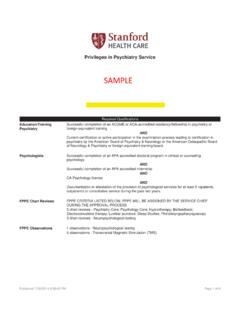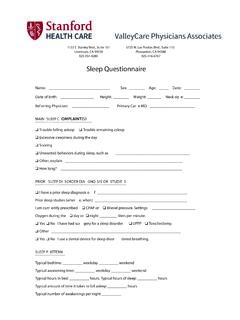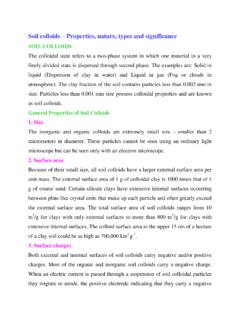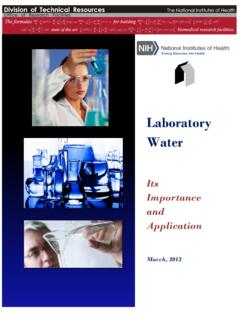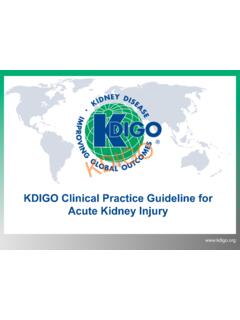Transcription of Guidelines for Intravenous Albumin Administration at ...
1 Stanford Health Care Created: 03/2017 Pharmacy Department Last Revised: Guidelines for Intravenous Albumin Administration at Stanford Health Care Policy: Pharmacists will evaluate all Intravenous Albumin orders prior to verification to ensure compliance with the criteria outlined in this guideline*. o All orders must include a definitive endpoint of therapy. o Doses will be rounded to the nearest vial size. Albumin is NOT approved for Pyxis override. These Guidelines do not apply to intraoperative use. *NOTE: To request use of Albumin that is not in accordance with these Guidelines , approval must be obtained from one of the physician approvers: Drs. Norm Rizk, Ann Weinacker, David Spain, or Charles Hill. Likely Benefit (Approved indications) Large Volume Paracentesis in Patients with Cirrhosis Defined as >4 L removed with documented cirrhosis (or any amount removed if creatinine is > gm/dL) Dosing recommendation: Albumin 25% 6-8 g per liter of ascitic fluid removed Plasmapheresis Dosing recommendation: Albumin 5% as per plasmapheresis protocol (based on plasma volume and serum fibrinogen level) May Benefit (Approved indications) Postoperative volume resuscitation after Cardiac Surgery Albumin 5% may only be used if 3 L crystalloid has been administered within a given 24-hour period without an adequate hemodynamic response.
2 This only includes crystalloids given as a bolus (excludes maintenance fluids, carrier fluids, etc.) This excludes fluid given intraoperatively For diagnosis of Suspected HRS Defined as acute renal dysfunction (serum creatinine > mg/dL) in the presence of cirrhosis Dosing recommendation: Albumin 25% 1 g/kg/day for 2 days (dose up to a maximum of 100 g per day) See #iii below for the definition of confirmation of the diagnosis. Hepatorenal Syndrome (HRS), confirmed Defined as: i. Serum creatinine > mg/dL in the presence of cirrhosis ii. Absence of shock, ongoing bacterial infection, and/or current treatment with nephrotoxic drugs iii. Absence of sustained improvement in renal function after discontinuation of diuretics and a trial of Albumin 1 g/kg iv. Absence of proteinuria (<500 mg/day) or hematuria (<50 red cells per high-power field) v. Absence of ultrasonographic evidence of obstructive uropathy or parenchymal renal disease Dosing recommendation: 1.
3 Albumin 25% 25-50 g daily for a total of 72 hours (starting 1-2 days after initial diagnostic trial of Albumin , if applicable), and consult nephrology and hepatology services to determine whether to continue 2. Should be used in addition to midodrine and octreotide Stanford Health Care Created: 03/2017 Pharmacy Department Last Revised: May Benefit, cont d (Approved indications) Spontaneous Bacterial Peritonitis (SBP) and cirrhosis Defined as patients with ascitic fluid PMN counts 250 cells/mm3 plus at least one of the following: creatinine >1 mg/dL 2. Blood urea nitrogen >30 mg/dL 3. Total bilirubin >4 mg/dL Dosing recommendation: Albumin 25% g/kg within 6-hours of detection (day 1) and 1 g/kg on day 3 Major Hepatic Resection (>40% resected) May be useful after liver resection in patients with serum Albumin < g/dL if crystalloids alone fail to achieve adequate intravascular volume.
4 Dosing recommendation: Albumin 25%, 25 gm/day until Albumin is gm/dL. If serum Albumin remains < , may continue Albumin dosing up to 4 days; consult liver surgeons thereafter for consideration of continued use. Postoperative Heart Transplant May be useful to treat anasarca in patients with Albumin 3 gm/dL Dosing recommendation: 1. Albumin 25%, 25 gm IV BID x2 doses (or gm IV q6h x4 doses) may be used in combination with diuretics. 2. Monitor urine output and volume status and assess daily. If successful at achieving diuresis, may reorder Albumin until serum Albumin is >3 gm/dL but must be renewed each day after daily assessment. Postoperative Lung Transplant Grade 2 or higher Primary Graft Dysfunction Dosing recommendation: Albumin 25%, 25 gm IV BID x2 doses (or gm IV q6h x4 doses) for up to 48 hours may be used in combination with diuretics to improve oxygenation. Postoperative Liver Transplant May be useful for the control of ascites and peripheral edema if serum Albumin is < gm/dl Dosing recommendation: Albumin 25%, 25 gm/day until Albumin is gm/dL.
5 If serum Albumin remains < , may continue Albumin dosing up to 4 days; consult liver surgeons thereafter for consideration of continued use. Unclear Benefit (Approval by nephrology attending required prior to use) Severe Nephrotic Syndrome ( with anasarca or pulmonary edema) May be used in demonstrated nephrotic syndrome (>3 g/day of urinary protein excretion [or spot protein equivalent] + hypercholesterolemia + hypoalbuminemia) and loop diuretic resistance (defined as an insufficient response to an Intravenous bolus dose of 160 mg furosemide or 4 mg bumetanide followed by 8-hour infusion of 20 mg/hr furosemide or mg/hour bumetanide) Dosing recommendation: Albumin 25%, 25 gm in combination with diuretics to effect adequate diuresis. Additional dosing must be approved by nephrology attending. Stanford Health Care Created: 03/2017 Pharmacy Department Last Revised: Not Indicated (Will NOT be approved) Acute Respiratory Distress Syndrome Maldistributive shock (eg.)
6 Septic Shock) Traumatic Brain Injury Major Trauma Hypoalbuminemia Kidney Transplant Hemorrhagic Shock Abdominal Compartment Syndrome Cost Comparison of Available Therapies: Product Description Price per Unit Price Key 1 Liter Normal Saline $ $ = $1 - $9 $$ = $10 - $24 $$$ = $25 - $50 $$$$ = >$50 1 Liter Normosol $ 1 Liter Lactated Ringer s $ 1 Liter Plasma-Lyte $$ 1 unit of Albumin 5% 250 mL: $$$ 500 mL: $$$$ 1 unit of Albumin 25% 50 mL: $$$ 100 mL: $$$$ Comparison of Therapy Components: Fluid pH Osmolarity (mOsm/L) Sodium (meq/L) Chloride (meq/L) Potassium (meq/L) Calcium (meq/L) Other: Normal SalineA 308 154 154 0 0 --- NormosolA 294 140 98 5 0 Mg = 3 meq/L Acetate = 27 meq/L Gluconate = 23 meq/L Lactated Ringer sA 275 130 109 4 3 Lactate = 28 meq/L Plasma-LyteB 294 140 98 5 0 Mg = 3 meq/L Acetate = 27 meq/L Gluconate = 23 meq/L Albumin 5%B 310 145 15 145 15 0 0 --- Albumin 25%B 312 145 15 145 15 0 0 --- (AHospira labeling information, BBaxter labeling information) References: General Literature: 1.
7 Vermeulen LC Jr, Ratko TA, Erstad BL, et al. A paradigm for consensus: The University Hospital Consortium Guidelines for the use of Albumin , nonprotein colloid , and crystalloid solutions. Arch Intern Med. 1995;155:373-379 2. Martelli A, Strada P, Cagliani I, et al. Guidelines for the clinical use of Albumin : comparison of use in two Italian hospitals and a third hospital without Guidelines . Curr Ther Res Clin Exp 2003;64:676-684 Stanford Health Care Created: 03/2017 Pharmacy Department Last Revised: Fluid Resuscitation in Critical Illness 3. Perel P, Roberts I, Ker K. Colloids versus crystalloids for fluid resuscitation in critically ill patients. Cochrane Database Syst Rev 2013;28(2):CD000567 4. Dellinger RP, Levy MM, Rhodes A, et al. Surviving sepsis campaign: International Guidelines for management of severe sepsis and septic shock: 2012. Crit Care Med 2013;41(2):580-637 5.
8 American Thoracic Society Critical Care Assembly. Evidence-based colloid use in the critically ill: American Thoracic Society consensus statement. Am J Crit Care Med 2004;170:1247-1259 6. Beekly AC. Damage control resuscitation: A sensible approach to the exsanguinating surgical patient. Crit Care Med 2008;36[Suppl.]:S267-S274 7. Finfer S, Bellomo R, Boyce N, et al. A comparison of Albumin and saline for fluid resuscitation in the intensive care unit. N Engl J Med 2004;350:2247 2256 8. van der Heijden M, Verheij J, van Nieuw Amerongen GP, Groeneveld AB. Crystalloid or colloid fluid loading and pulmonary permeability, edema, and injury in septic and nonseptic critically ill patients with hypovolemia. Crit Care Med 2009;37:1275 1281 Renal Transplantation: 9. Abdallah E, El-Shishtawy S, Mosbah O, et al. Comparison between the effects of intraoperative human Albumin and normal saline on early graft function in renal transplantation.
9 Int Urol Nephrol 2014;46(11):2221-6. Liver Transplantation: 10. Johnson PN, Romanelli F, Smith KM, et al. Analysis of the morbidity in liver transplant recipients following human Albumin supplementation: A retrospective pilot study. Progress in Transplantation 2006;16:197-205 11. Ertmer C, Kampmeier TG, Volkert T, et al. Impact of human Albumin infusion on organ function in orthotopic liver transplantation a retrospective matched-pair analysis. Clin Transplant 2015;29(1):67-75 Paracentesis/Spontaneous Bacterial Peritonitis/Hepatorenal Syndrome 12. Runyon, AASLD Practice Guidelines Committee. Management of adult patients with ascites due to cirrhosis: update 2012. Hepatology. 2013;57:1651 1653 Nephrotic Syndrome: 13. Duffy M, Jain S, Harrell N, et al. Albumin and furosemide combination for management of edema in nephrotic syndrome: a review of clinical studies. Cells 2015;4(4):622-630 Cardiac Surgery: 14.
10 Frenette AJ, Bouchard J, Bernier P, et al. Albumin Administration is associated with acute kidney injury in cardiac surgery: a propensity score analysis. Crit Care 2014;18(16):602 15. Lee EH, Kim WJ, Chin JH, et al. Effect of exogenous Albumin on the incidence of postoperative acute kidney injury in patients undergoing off-pump coronary artery bypass surgery with a preoperative Albumin level of less than g/dL. Anesthesiology 2016;124(5):1001-11 Acute Respiratory Distress Syndrome/Acute Lung Injury: 16. Cribbs SK, Martin GS. Fluid balance and colloid osmotic pressure in acute respiratory failure: Optimizing therapy. Expert Rev Respir Med 2009;3:651-662 17. Martin GS, Mangialardi RJ, Wheeler AP, et al. Albumin and furosemide therapy in hypoproteinemic patients with acute lung injury. Crit Care Med 2002;30:2175-2182 18. Martin GS, Moss M, Wheeler AP, et al. A randomized, controlled trial of furosemide with or without Albumin in hypoproteinemic patients with acute lung injury.




